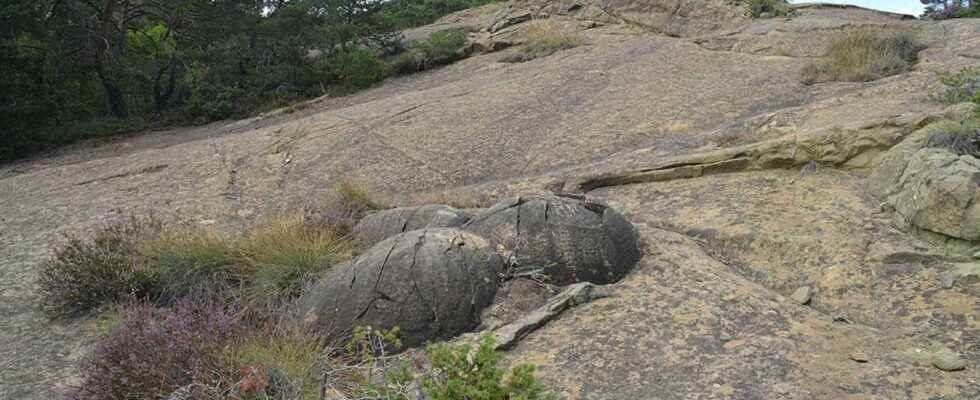You will also be interested
[EN VIDÉO] Earth’s history seen from space Since the end of the Second World War, Man has gained height and finally been able to admire the world he inhabits. From space, the Earth is beautiful, diverse and yet united, borderless. From up there, “we can see the fragility of the Earth,” said astronaut Thomas Pesquet. It’s an oasis in an ocean of nothing.
France is rich in geological curiosities that are sometimes little known and yet spectacular. Near the village of Saint-André-de-Rosans, in the Hautes-Alpes, there are concretions very special sandstones, which are worth a detour.
These balls of 1 to 2 meters in diameter which seem to come out of earth are nothing dinosaur eggs ! Nor were they shaped by the hand of man, even if their regularity might lead one to think so. No, these are indeed spheres of natural origin and more precisely diagenetic concretions of sandstone.
These geological formations are part of a sedimentary series deposited in the Albian, around 100 million years ago. Very surprisingly, the formation of the balls of Rosans still remains enigmatic.
Sand turned into sandstone
Originally, the sandstone bench that contains them and on which one can walk was nothing more than a deposit of sand, as can be found on the coast. In the Albian, the region was indeed submerged under the waters of an ancient ocean. The sand at the origin of the balls was then deposited on the slope of a marine pit, called the Vocontian pit. These sand deposits are the result of underwater avalanches, reaching a deep environment normally dominated by a sedimentation marl, which can be observed in particular on the site, at the base and at the roof of the sandstone unit.
Burial linked to the progressive accumulation of new sediment then led to the start of the diagenesiswhich brings together all the processes leading to the transformation of loose sediments in hard rocks. We are talking about lithification. In the case of the Saint-André-de-Rosans site, it is therefore the transformation of a sandstone sand deposit. Diagenesis is thus accompanied by mechanical compaction linked to the accumulation of sediments, to a dehydration, dissolution and cementation processes. Water-rock interactions play an essential role throughout the transformation.
Balls unearthed by the erosion of the more friable sandstone bed
But why did this process lead to the formation of the sandstone ball? To understand, you have to take a closer look at these strange formations. Their detailed study shows that the spheres seem packed in the sandstone bed which here takes on a greenish hue, a sign of the presence of a mineral : glauconia. We understand that they were put at theoutcrop by erosion which has gradually removed this gangue of softer glauconious sandstone. To the touch, it actually appears very crumbly. The bare balls seem on the contrary to be composed of a more resistant sandstone, the result of better cementing.
Some balls present an alteration in peels ofonion : the sandstone that composes them seems to go in layers, signifying an internal structuring of concentric shape, with differences in hardness sandstone running from the center to the periphery.
A central core made of small pebbles
Another clue, a ball fractured in two makes it possible to observe the presence, in its center, of small pebbles, while the rest of the sphere is composed of a fine and homogeneous sandstone, without coarse elements. This observation makes it possible to suggest that the balls, or at least some of them, were formed by progressive and concentric gresification around a central core. At the start of diagenesis, crystallization inside the sandy sediment is in fact favored by the presence of an “impurity” — a fragment of shell or pebble — which will act as a core of nucleation and attract the crystallization of carbonates. The ball will thus form by successive crystallization in all directions, the sediment surrounding the core being more or less homogeneous.
This kind of geological formation is not unique and has been observed in many places around the world, often less spectacularly.
To discover the site, all you have to do is survey the hills located to the north-west of the village of Saint-André-de-Rosans, the site is indicated on the IGN maps by the indication “Boules de grés”.
Only a few days left to take advantage of our special offer for Father’s Day!
Your father is a great science enthusiast and unusual discoveries? And if you offer him a superb scientific exploration in paper format? Benefit from -20% on the Mag Futura (special offer: €15 instead of 19 €): 220 pages, 4 key issues deciphered to understand everything about the science that will mark 2022.
Special offer: -20% reduction on the Mag Futura
Mag Futura is:
- 4 major scientific questions for 2022, from the Earth to the Moon
- 220 pages, 60 experts
- Home delivery
- Electronic gift card
Interested in what you just read?
